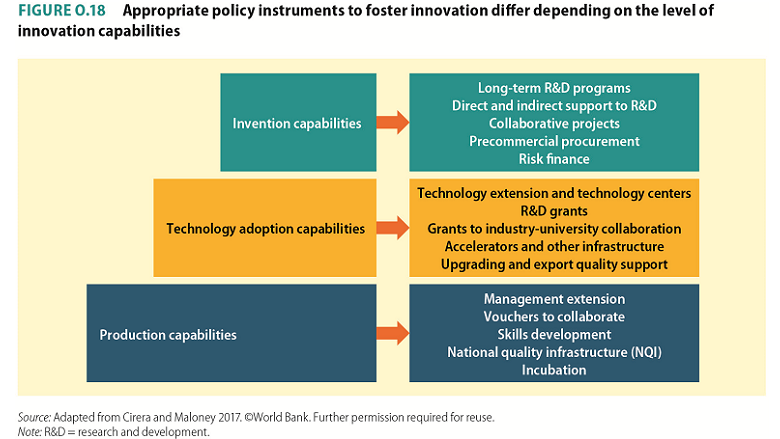
The World Bank
Key Findings
The Context
- Productivity growth has declined since the Global Financial Crisis
- Changes in global trade and technologies are challenging countries’ key engine of growth – export-oriented manufacturing, and
- The COVID-19 pandemic and other shocks, including climate change, are accelerating the need for new modes of production.
The Challenge
- Although the region has experienced some noteworthy successes, most countries in the region (except for China) underperform on several key indicators of innovation.
- And while countries have narrowed the gaps with advanced economies in the initial adoption of new technologies, they are falling behind in the broad diffusion and use of those technologies.
- Moreover, there is significant heterogeneity in innovation performance across in the region – between countries and within countries, across sectors and firms.
- Innovation appears more prevalent in manufacturing than in services, even though services are increasingly important to the region’s economies, including as inputs to manufacturing.
- Most firms remain far from the technological frontier, and only a small share of firms engages in more sophisticated innovation activities, including cutting-edge research and development.
What do we mean by “Innovation”?
- People commonly associate innovation with breakthroughs at the technological frontier, and such breakthroughs often capture the imagination of policymakers and the media.
- The Innovation Imperative for Developing East Asia defines innovation more broadly, however, to include both “invention” (i.e., developments that push the technological frontier), and the “diffusion” and “adoption” of existing technologies and practices that result in significant improvements in the ways firms produce or operate. Diffusion and adoption are well-suited to the capabilities of the vast majority of firms operating in developing East Asia.
What inhibits innovation?
New evidence shows that several factors impede innovation in the region.
- Firms often lack adequate information about new technologies and high uncertainty about the returns to investment in innovation
- Firm’s innovation capabilities, including management quality, are often weak
- Firm employees frequently lack the skills needed to enable innovation
- Limited financing options hinder firms’ ability to fund innovation projects, and
- Countries’ innovation policies and institutions are not aligned with firms’ capabilities and needs.
- They favor invention over diffusion and adoption
- They favor innovation in manufacturing over innovation in services, and
- Links between national research institutions and private sector firms remain weak, as do incentives for research institution-industry collaboration.

What will it take to spur innovation in the region?
To spur greater innovation – both diffusion and invention – country policymakers need to
- Reorient innovation policy objectives to
- Promote diffusion and adoption of existing technologies, not just invention
- Support innovation in the services sectors not just in manufacturing
- Invest in building firms’ innovation capabilities
A key objective of innovation policy should be to increase the number of firms engaged in any form of innovation – diffusion, adoption, invention – and progressively increase the share of firms transitioning from technology adoption to more sophisticated forms of innovation.
- Strengthen key complementary factors for innovation, including
- Developing students’ and workers’ skills for innovation –stronger foundational skills as well as advanced cognitive, technical, and socio-emotional skills
- Improving finance for innovation through continued capital market deepening and more diverse financial instruments to support innovation
- Raising management quality
- Reform innovation institutions and agencies and strengthen their capacity through
- Increasing institutional capacity to design and implement innovation policies
- Improving governance of innovation institutions and agencies along with interagency coordination
- Strengthening linkages between research institutions and firms, including incentives for research institution-industry collaboration.
The term “developing East Asia” refers to the 10 middle-income countries covered in this study: Cambodia, China, Indonesia, Lao PDR, Malaysia, Mongolia, Myanmar, the Philippines, Thailand, and Vietnam.